
|

|
| Mojave
Expedition (11-12-05)
photo gallery--Click the
photo to go to the gallery |
|
Burro
Schmidt's
Tunnel
Update |
|
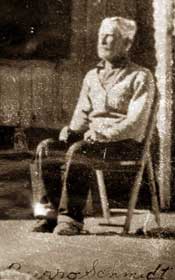
Burro
Schmidt's "Famous Tunnel" now has a group of
"friends" trying to preserve and protect the
site. Click
the photo to visit their Website. |
|
|
|
Click on
the photo below to read more about Cerro Gordo.

Cerro
Gordo now has its own Web site. Click the link below to visit. 
|
|
|
|
|
|
|
|

The
Panamint Breeze
is a new publication highlighting the history and legends
California and Nevada.
Click
on the logo for
details. |
|
|
Memories
of Mono Mills
and
The
Bodie Railway
by
Cecile
Page Vargo |
|
The treeless gold mining town of
Bodie
, California
, boomed in the
1880's, and the demand for lumber was great.
Wagons hauled construction timber from the sawmills in
Bridgeport
and
Mono
Lake
, and enterprising
Chinamen on burros packed cordwood to fuel mining machinery and heating
stoves. The town would boast
some 10,000 citizens during this time, and the wood couldn't be brought
in fast enough to take care of all of their needs, particularly during
the harsh winters. In 1881, the Bodie Railway & Lumber Company was
created to resolve that problem. A three foot gauge line was built from
Bodie to the Mono Saw Mills. A modern visitor to the site at the
southern side of
Mono
Basin
would be hard
pressed to imagine the railroad shops, lumber mills and logging camps
that once stood in the ravine below the historical marker off of modern
day highway 120.
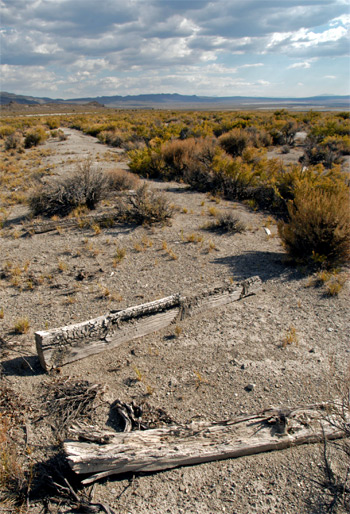 |
| A
few old ties remain on the Bodie Railroad right of way. View is
looking north to Mono Mills. |
The
Saw Mill Operations
Emil Billeb, was a key player in both Bodie & Mono Mills
history. We borrow stories from his book Mining Camp Days
to take us back to the early 1900's when these places were still hanging
on to life. He uses
newspaper quotes from a
journalist who visited Mono Mills in 1882 to help us picture the actual
mill operations during both time periods:
"The saw mill, being the chief object of interest to a new
arrival, the reporter immediately proceeded to inspect the machinery and
its general workings. This is a large and well equipped mill - one of
the best on the coast. It is located about five miles and a quarter from
the bank of the lake in a small ravine. The upper story of the building
is on level with the surrounding country, so there is no trouble
whatever in rolling the logs into the mill.
The logs are first passed through the upper and lower saws, which
are fifty-four inches in size… There are three other saws in the mill
- one being a forty-four inch pony and two cut-off saws…
The machinery of the mill is propelled by an engine with a
sixteen inch cylinder. These saws have a capacity of turning out 80,000
feet of lumber every ten hours…The water supply is brought from
springs in a two inch pipe and there is enough for all practical
purposes.
The company's lumber tract embraces 12,000 acres and some of it
is covered with immense pine. From the mill site a pretty view can be
obtained of the lake and altogether the
location is inviting" (Weekly
Standard News,
October 12, 1881
.)
"Please Pass The
Turkey
"
In the spring of 1908, Billeb traveled from Tonopah, seven miles
by train, 35 miles by
Concord
stage, to find the
once thriving town of
Bodie
diminished to a population of 300. The Bodie Railroad
& Lumber Company was under new management and he was to be the
representative. Both the railroad and Mono Saw Mill were in considerable
disrepair, and would be refurbished to run much longer than most
antiquated operations of it's kind would have.
During Billeb's stay, the days of the "bad man of
Bodie" were gone, but
there were still plenty of shenanigans going on amongst those who lived
and worked there..
The company saloon at Mono
Mills was operated in
connection with the commissary and gambling and drinking provided most
of the entertainment. On payday, a good portion of hard earned payroll
went to the bar., and the usual liquor induced brawls took place. The
liquor business came to it's
death, however, after someone was
almost killed. Thereafter,
potables were smuggled into camp.
"
Turkey
" became the
password thirsty Mono Mills workers would use for a bottle of bourbon
during the company's prohibition period. As he passed through camp on
his way to Bishop, one of the men asked the store clerk if he could
bring him anything when he came through again. "
Turkey
" was the clerks
reply. It was late at night several days later, when the man returned.
The following morning when the clerk asked of he had remembered to bring
the "turkey", the man assured him that he had and it was well
hidden in the barn. The clerk went to the barn, with thoughts of a good
shot of whiskey to whet his whistle. As he opened the barn door, much to
his surprise a live bird flew out past him and into a tree. The cuss
words must have flown out of
the clerks mouth as fast as the turkey
did!
The Chinese Cooks
The boarding house at Mono Mills often hired Chinese cooks. One,
known as Chan Yee, was known for his drinking abilities, and often
became the brunt of practical jokes. He made a point of being the first
at the company commissary each morning as it opened, so he could start
his day off with a good stiff drink of whiskey.
If Chan didn't get his whiskey there would be no breakfast. One
morning as Chan came in for his usual drink, he was poured a large
water size glass full by the clerk. Chan gulped down the entire
glass, cussing in his native tongue immediately afterwards. The whiskey
was vinegar. No one was served breakfast at the boarding house that
morning! Yet another morning, following a particularly hard bout of
drinking, Chan Yee discovered himself on the wooden floor of the
blacksmith shop with his queue stapled to the floor. After much
screaming and hollering, help arrived. Chan swore to kill the
pranksters, but fortunately for them, he never discovered who they were.
Needless to say the boarders at Mono Mills went hungry once again.
Chinese cook, Tim, spent a summer at the Mono logging operations
cooking for the boarding house, also. He got along well with the large
crew of loggers, teamsters and others that he had to cook for. By and by
complaints started coming to Tom Miller at the Mono Mills store. It
seems that all Tim was cooking was stew, and the crew was hankering for
something more. An investigation soon revealed that steaks, roasts and
other variety of meats were sent to the boarding house, but Tim and his
Indian friends were enjoying them instead. His indulgences left him
short of good meat for the boarding house so he had been trapping the
chipmunks that hung around the stable and plopped them into the stew
instead. It was Emil Billeb's job to fire him and hurry him out of the
logging camp before he was beaten by the crew.
Indian Pursuit
A colony of Paiute Indians spent summers at Mono Mills, living in
wickiups, and working for the railroad company. Many were good workers,
but they enjoyed gambling and drinking. It was common for them to lose
their entire paycheck, saddles, and horses at one sitting. They also
enjoyed firewater when they could get it. One particularly good workman,
would go to a Chinaman in Bodie for dope or hop, when he couldn't get
alcohol. If there was no train available he would walk the thirty long
track up into the Bodie Hills and into town. Often he got into trouble
with the law. On one early morning trek,
as he was being taken by the constable to the Bodie town jail,
this Indian managed to break away from the constable. He ran up the hill
toward the lumber yard, the law officer following him. As the constable
fired a shot at him, the Indian increased his running speed. He sat down
and removed his shoes, put them under his arm and headed through the
brush on his bare feet. The constable encouraged him on his way with a
few more shots.
The Robbery
Charlie Cease was clerk at the Mono Mills store in 1915. He got
to work early one morning to find out that the safe had been broken into
and $100 or so in company funds had been stolen from it. The envelopes
of funds left by mill workers for safe keeping were untouched. Emil
Billeb was called to investigate. He asked Charlie to keep the theft to
himself, but to check outside the store near the door for footprints and
any other clues he could find. As the clerk did so, the boarding house
cook known as "Fat" McLaughlin came for breakfast supplies and
asked what Charlie was looking for. Charlie made up a story about a
twenty dollar gold piece that had been dropped by one of his customers.
Instead of deterring Fat's interest in the what he was doing, it made
him more curious. Fat got his supplies and cooked the crews breakfast as
usual, but couldn't wait to get back to the store and start looking for
the twenty dollar gold piece. He set up a screen similar to one used for
mixing mortar, and began shoveling sand against it to sift out the gold
piece. He spent a hot day shoveling volcanic pumice and sand, but the
more he shoveled it became obvious that there was no coin to be found.
Charlie was now afraid that he would be beat by Fat if he told him what
he had really been looking for early that morning. No one ever told the
cook the truth, and no clues were ever found about the missing company
funds. The thief of Mono Mills store got away with his crime, $100
richer for it.
Snow Train Trek
The route back and forth from Bodie to Mono Mills by train was
difficult, particularly in the fall and winter before snows fell and
work crews were reduced. In December of 1910 one train took five miles
to traverse the 32 miles. This train consisted of an engine with a
v-type snowplow on the pilot, a car of fuel wood, and two flat cars
loaded with a gasoline engine and other equipment.
On the first day out, a car jumped the track and had to be
returned to Mono Mills. The second day, a few miles north of Lime kiln,
deep snow drifts slowed travel and it was late afternoon before the high
trestle eight miles from Bodie was reached. The train bucked snow which
became deeper and deeper the steeper the grade got. At
midnight
, the only car
still coupled to the engine started to slide down the side of the
canyon, and had to be dropped.
The four man crew and two passengers huddled about the boiler of the
engine cab to thaw out, as temperatures dipped to twenty below zero.
When steam pressure dropped, the engine stopped, and everyone would
climb out to clear the track, shovel snow into the tender, and look for
ties hidden in the snow that could be used for fuel. Within 10 minutes
of leaving the cab, everyone's clothes had frozen stiff.
The engine completely stalled, two hours later, four miles short
of the Bodie terminal. From here everyone got out and walked through
waist deep snow. It was another three days before the engine would reach
the roundhouse. Water and fuel was hauled by sleigh, and additional help
was obtained to clear the track.
Spring time created difficulties for the train as well. As winter
ended, the snow would melt during the day, but freeze up again at night.
After dark a sleigh load of lumber or wood traveled over the crusted
snow easily, but after sunrise the
melting ice crust was impassable. Most early spring deliveries were made
between
midnight
and sunrise.
Ghosts of the
Sagebrush
Today Mono Mills is one of many ghosts of the sage brush in the
Mono
Basin
area. Join us as we
discover those ghosts first hand during our Land of Volcanoes tour,
June 24-26, 2006, which includes a portion of the Ghost of the
Sagebrush tour put on by the Mono Basin Historical Society.
For more
information, see Terri Geissinger's story below.
Bibliography
Mining
Camp
Days
by
Emil W. Billeb
Howell-North
Books
Berkeley
,
California
1968
|
| |
|
Mono
Mills to Bodie
by
Robert
C. Likes |
|
Situated in a tranquil setting on the desert side of the
Sierra Nevada
,
Mono
Lake
has been
referred to as “the Dead Sea of America.” This large brackish
body of water contains a high percentage of sodium sulphate, two
small islands, no marine life, and very little vegetation on its
shoreline. The soil of the surrounding terrain is largely volcanic
sand and pumice which barely supports the growth of sagebrush, and
in places, is devoid of any growth.
The paradox to this picture is the forests of Jeffrey and
lodgepole pine a few miles south of Mono
Lake. It is
surprising that this country could bear trees, and incredible that
they would mature to four feet in diameter. However, the country
does, and the trees did, and therein lies the birth of a railroad.
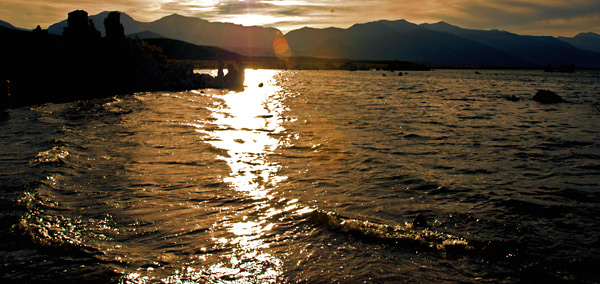 |
| Mono
Lake at sunset looking west to the Sierra Nevada Mountains. |
Huddled in the sagebrush-covered mountain, 30 miles north of Mono
Lake, was the
brawling, boisterous, gold mining town of Bodie, California. With a soaring
population of nearly 12,000, the town’s need for lumber to build
homes, timber for shoring mines, and wood for fuel was tremendous.
teamsters could not begin to meet the enormous appetite Bodie had
for consuming wood. The stage was set for the obvious answer to the
problem - build a railroad to the large timber stands south of Mono
Lake
.
 |
| Bodie,
California as seen from the cemetery. |
The Bodie Railway and Lumber Co. was organized on February
18, 1881, and shortly afterwards, J. T. Oliver surveyed the route
from Bodie to the mill site five miles south of Mono Lake.
When completed, the proposed 31.7 miles of roadbed was to
descend the 2,000 foot drop in elevation and traverse the alkali
flats on the eastern shore of Mono
Lake. Thomas Holt, an
engineer, was selected to ramrod the project. In addition to this
task, Holt was operating a five-ton steamship and several barges on
which materials and supplies were transported across Mono
Lake
to the railroad
construction crews.
While the sawmill was being built, grading for the roadbed
was started at the top of Bodie Bluff in May, 1881. With the aid of
two switchbacks, many cuts, and a 260-foot trestle, the steep and
circuitous grade down to lake elevation was accomplished, and by
mid-July, the first 20 miles of roadbed had been graded.
The first shipment of rails arrived in August, and as they
were being spiked into place, the final five miles of grading was
completed to the new mill. In all, some 2,00 tons of rails, spikes
and other supplies were used. The total cost of the road reached
$450,931. In addition, $81,390 was spent for equipment that included
4 engines, 12 service cars, 51 flat cars, and one caboose. The
“last spike” was driven on
November 14, 1881
, and a two-car
lumber train arrived afterwards to officially open the road.
The following weeks saw the new railway quite active with a
scheduled train leaving Bodie each day at
6:30 A.M.
and arriving at
Mono Mills at
10:00 A.M.
The train
departed the mill at
2 o’clock
each afternoon,
and arrived back at Bodie by
6:00 P.M.
The ten - to
twelve-car train was broken up into three sections prior to the
final approach to Bodie in order to negotiate the switchbacks and
3.8% grades. In addition to the problems caused by the sharp turns
and steep grades, the rolling stock was not equipped with air rakes.
Two brakemen were kept busy hopping from car to car setting the hand
brakes whenever the train began to gain momentum. There were many
derailments, but no fatalities among the crewmen were ever recorded.
The southern terminus at Mono Mills, while not a large
settlement, was a busy one. There were 200 men employed in the wood
and lumber business, and the aroma of fresh sawdust was everywhere.
Two large boarding houses and six smaller dwellings were located
near the mill. The single store supplied all the necessary goods
required by the residents, and was operated by Gilchrist, Sharp
& Company, who also had 40 mules packing wood, and two large ox
teams hauling lots to the mill.
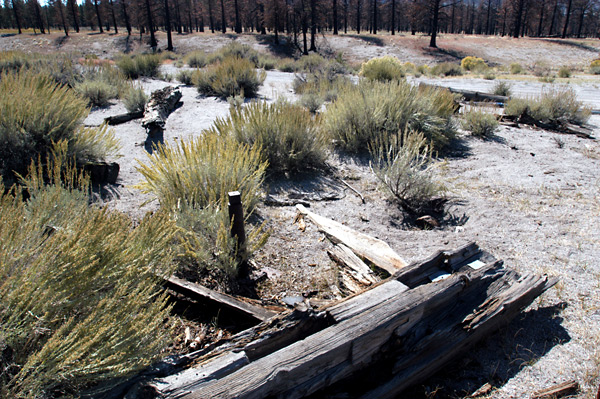 |
| Remains
of structures at Mono Mills today. |
The well equipped mill was one of the best in the state.
Located in a small ravine, the second floor was level with the
surrounding country so the heavy logs could be easily rolled into
the mill where 54 inch circular saws quickly reduced their size. One
44 inch “pony” and two smaller cut off saws completed the task
of transforming logs to lumber. The machinery was powered by a steam
engine, and water was obtained from springs and transported to the
mill by 2-inch pipe. The mill had the capacity for turning out
80,000 board feet every ten hours.
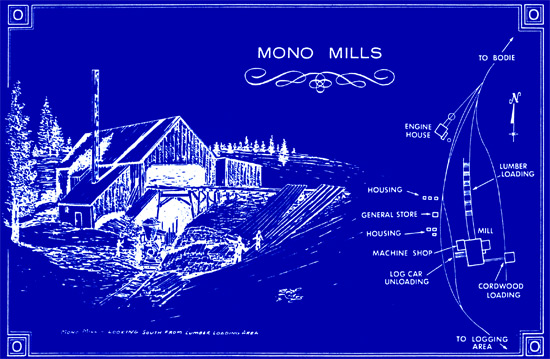 |
| Drawing
of Mono Mills and Bodie RR trackage by Robert C. Likes. |
The greatest portion of Mono Mills output was in cordwood.
This relatively poor quality of wood was used as fuel to produce
steam power for the hoists and stamp mills at the Bodie mines. This
demand kept the flat cars loaded to capacity and helped offset the
low yield of only 8,000 board feet per acre for construction lumber.
The “last run” of the season was made on
January 7, 188, after which the
railroad closed down for the winter.
Read
More
|
|
How
Do You Burn 300 Cords of Wood a Day?
by
Terri
Geissinger |
|
Easy. You build a mining town in
the 1800’s when steam engines powered everything. Two important
elements for steam…wood and water.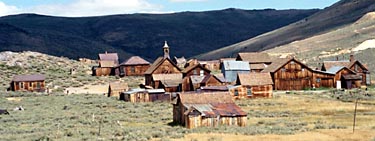 Bodie had neither. At the height of Bodie’s population and mining
production, the town was consuming an impressive amount of wood. In
fact, wood became as valuable as the gold. The town that grew to be the
second largest city in California in 1880, is located at 8375 feet
elevation with not a tree in sight and other then a snow fed creek, not
much water either.
Bodie had neither. At the height of Bodie’s population and mining
production, the town was consuming an impressive amount of wood. In
fact, wood became as valuable as the gold. The town that grew to be the
second largest city in California in 1880, is located at 8375 feet
elevation with not a tree in sight and other then a snow fed creek, not
much water either.
The miners dug deep into
Bodie Bluff for gold and silver. The precious rock was brought up out if
the mines with huge steam operated hoists. These hoists were fed nine to
12 cords each per day. There were 32 active mines and nearly 60 miles of
tunnels underground. Large timbers were needed to shore up the walls of
the mines to keep them from caving in. Giant pumps were set in place to
keep the water from filling in the deep mines. 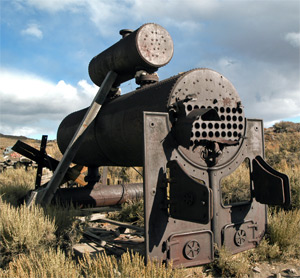 These
impressive pumps could pump 800,000 gallons of water every 24 hours.
Each large pump consumed 24 cords of wood per day. Nine powerful stamp
mills crushed rock as fine as cinnamon. The fine powder was then
introduced to the mercury process where the gold and silver would
separate from the waste rock. These stamp mills required lots of wood to
operate. The Standard Mill alone used 24 cords a day. Gosh, we haven’t
even discussed the 2000 buildings that once stood in the old town. Not
to mention the wood needed for cooking and heating. (Last week, the
temp. dipped -18...it’s a mild winter). These
impressive pumps could pump 800,000 gallons of water every 24 hours.
Each large pump consumed 24 cords of wood per day. Nine powerful stamp
mills crushed rock as fine as cinnamon. The fine powder was then
introduced to the mercury process where the gold and silver would
separate from the waste rock. These stamp mills required lots of wood to
operate. The Standard Mill alone used 24 cords a day. Gosh, we haven’t
even discussed the 2000 buildings that once stood in the old town. Not
to mention the wood needed for cooking and heating. (Last week, the
temp. dipped -18...it’s a mild winter).
Now lets say you lived back
in those days and you’re in the business of making money…You might
invest in the mines or set up general store, could get into the
freighting business, you would certainly do well with a saloon. No
matter where you decided to invest your money, there was one commodity
that was obvious; every person that lived in that town, or anywhere else
for that matter, needed one thing. Wood.
I imagine it was over a
whiskey when the men got together to discuss the idea of acquiring the
vast amount of land east of
Mono
Lake
. This group of influential men had names you might recognize today.
Yerington, Bliss, Ralston, Haney along with the Cook brothers were among
others who would ultimately acquire 12,000 acres of prime timber land.
This area was heavily forested with Jeffrey pine. In 1881, this group
officially formed the Bodie Railway and Timber Company.
Mono Mills was completed in
August 1881. The powerful mill had state of the art machinery and was
larger then the famous mill of Carson& Tahoe and Fluming Company.
The capacity of the new mill was estimated to be 15 million feet of
lumber and 100,000 cords per year. The sound of the steam engines could
be heard for miles as the saws turned out 80,000 feet of lumber every 10
hours. Over 200 men were eventually employed by the company and a
settlement was established around the mill. Company boarding houses,
management houses, a store and no surprise, a saloon was soon frequented
by the employees.
The first order to complete
was the ties for the railroad that would reach 32 miles up to Bodie. The
ties measured were six by eight inches and seven feet in length. During
the month of September, 29,000 were cut.
November 14, 1881
the last spike was driven and the railway was complete. It had cost the
company $460,000. The railway consisted of four steam locomotives, 30
flatcars, a tank car and five logging cars.
As you well imagine, the
history of this place is fascinating. The people, the place, the
incredible hard work and the investment alone is enough to fill a book
or two. If you are interested in learning more about this great place in
history, I invite you to join us on
June 24, 2006
where we will honor the history of this historic site. The Mono
Basin Historical Society is holding its 4th Annual Ghosts
of the Sagebrush Tour at Mono Mills. This is a fund raising
event to benefit the
Schoolhouse
Museum
in Lee Vining. Because there is so much history to this place we have
plenty of help to put this day together. Friends of Bodie, U.S. Forest
Service, Friends of Bodie Railway and the Mono Lake Committee will join
and co-sponsor this event. Tickets are $15 per person
For more information contact Terri at
Bodie
State
Historic
Park, (760) 647-6445. |
|
Tour Information--REVISED
6/06 |
|
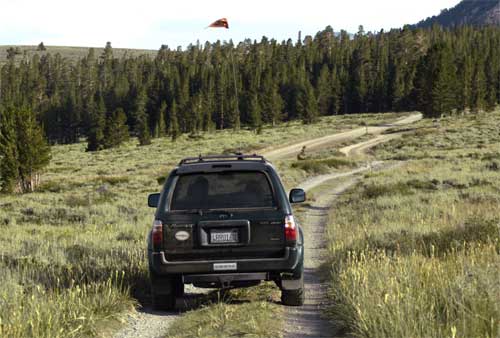
We're back on the road again!
Our 2006 permits are
preliminarily approved.
Our LAND OF VOLCANOES
tour, June 24-26 is on.
Please
click on the photo for tour details.
Please contact us at info@explorehistoricalif.com
for additional information or reservations.
|
|
Explore Historic California! |
|
Not too many years ago, the family station wagon was the
magic carpet to adventure. Today, that family station wagon is likely to
be a four wheel drive sport utility vehicle or pick up truck. SUV's and
other 4x4's are one of the best selling classes of vehicles. Ironically,
industry statistics show that once purchased, few owners will dare to
drive their vehicles off the paved highway. Click your mouse through our
website and enjoy our armchair adventures and the histories behind them.
If you are interested in taking one of our guided tours with your
vehicle, please contact us at: info@explorehistoricalif.com.
Several years ago, we bought our first SUV. We went to a one-night class
at a local community college entitled "How to 4-Wheel Drive" by Harry Lewellyn.
The following weekend we attended the hands-on day tour. We liked what we were
doing so much that we began going out nearly every weekend and learned how to
negotiate a variety of dirt roads. Our spare time was spent doing research on
the history and ecology of our favorite areas. A one-day outing turned into 16
years of leading others on mini-vacations throughout Southern California and the
Owens Valley.
Our 4WD outings involve driving on easy to moderate dirt roads and are
ideally suited to novice and intermediate level drivers. All tours are suitable
for stock vehicles in good condition, although some tours do have vehicle size
restrictions.
Our tours are
operated under permits issued by the Bureau of Land Management, U.S.
Forest Service, and other authorities.
We share our knowledge of the backcountry over the CB radio with our
guests. We frequently stop to explore mining areas, old and new, and ponder the
rocks, plants and animals we may encounter. We'll occasionally visit an old
cabin or deserted mountain lookout.
California has a fascinating history, from geologic unrest and
prehistoric petroglyph scribes to the "Radium Queen of the Mojave" and the
"Human Mole of Black Mountain." Load up your 4X, fasten your seatbelts and get
ready to explore historic California.
Roger, Cecile and Marty |
|
